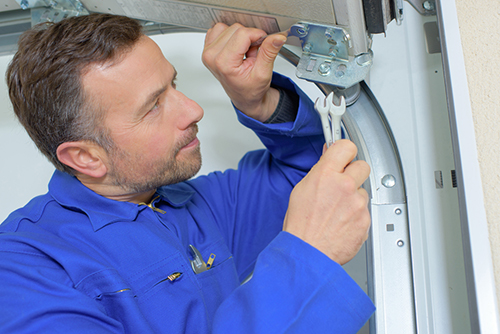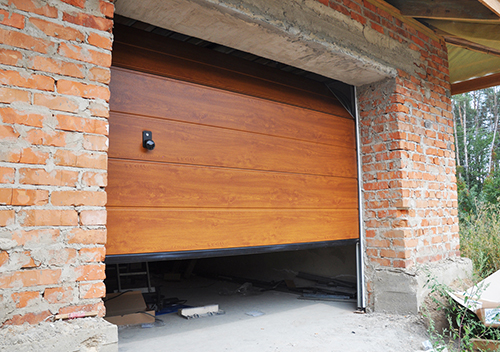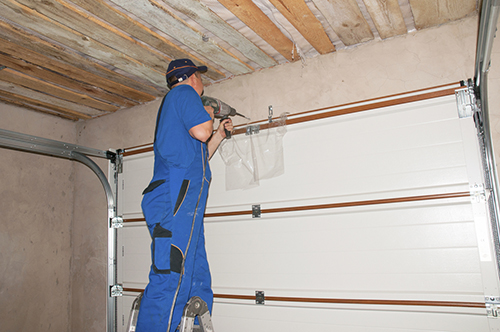Broken garage door springs are one of the most common types of garage door repair. Most people think the motor is responsible for moving the door. The springs lift the heavy weight and then provide the tension to let it back down smoothly. When the spring breaks, your big heavy garage door is no longer so easy to control. These essential parts help the garage door go up and down when you want it to. But how do you know if that’s the reason your garage door isn’t working properly?

The tips below will help you figure out if it’s time for new garage door springs or a new garage door. It’s good to know which choice to make since the cost of spring replacement is much more affordable than a new door.
Here’s what to look for…
-Broken Garage Door Springs
-Take a Look
Most garage doors have visible springs that you can see without much effort. There are two torsion springs on either side of the door that hold the cables secure on the drums. The exception to the rule is the style door which has the springs secured inside a tube. Since you can’t tell by just looking, you will need to test the door by lifting it. A broken spring allows you to lift the door manually but it won’t let it go back down.
You can also look for a 2-inch gap in the spring. The ends of the spring are fixed in place. When the spring breaks, the metal moves away from the middle.
-The Doors Fall Down Quickly
When you use the automatic opener to open the door, a broken spring might not be able to support the weight of the door, causing it to fall down faster than normal.

-The Door Goes Up a Little Ways
If you start to leave or come home to find that your garage door will only go up about half a foot and stops, it’s probably the spring. This is a built-in safety feature that prevents the door from going up any further. Otherwise, it could cause much more expensive damage than broken garage door springs.
-Jerky Movement in Either Direction
Jerky movements sometimes signal a single broken spring in a two-spring door system. This sign is most often seen with doors made with extension springs.
-The Door Goes Up Slowly with the Automatic Opener
Some types of garage doors open slowly at first before speeding up. A broken spring can cause them to stay in slow motion when it can’t lift the weight of the door. When this happens, test the door by closing it and then pulling the emergency release cord. Try to raise the door manually. If it is too heavy, then you probably have a broken spring.
-The Pulley and Cable are Hanging Down
When a spring breaks, it produces a lot of force. The cables can break, become twisted, or get caught on the track.

-You Here a Loud Sound Like a Gunshot
Garage door springs have a lot of pressure on them due to the torsion in the coiled design. When a spring breaks, it uncoils quickly, causing a loud sound that sounds like a gunshot. If you happen to be close by when the spring breaks, the noise can frighten you. If the door doesn’t have a safety cable through the spring, it is also dangerous. You should always have safety cables on your garage door.
-The Top of the Door Is Bent
There are different types and configurations of garage doors. Depending on yours, trying to open it with the garage door opener when it has a broken spring could bend the upper part of the door. When this happens, you may have to replace the upper portion of the door or buy a new door instead of just replacing the broken garage door springs.
-The Door Won’t Lift When You Pull the Emergency Release Cord
If you can’t lift the door up after you pull the red emergency release cord on the opener, it’s probably due to a broken spring. If you have to lift it to get out, you will probably need some help to make sure it lifts evenly and safely.
-The Door Isn’t Even While Lifting or Lowering
This is true for garage doors made with extension springs. There are two springs mounted on either side of the door and each works independently of the other. When one spring breaks, it fails to lift the door on that side.
All Garage Doors Are Not the Same
In addition to the different ages of garage doors, there are also different styles. Regular maintenance, including spraying lubricating oil or silicone on the springs, improves their longevity. Those made with two torsion springs are easier to lift with one broken spring because they have a second spring to do some of the heavy lifting.
What to Do When You Think Your Garage Door Needs Repair
Most experts agree that repairing broken garage door springs isn’t a do-it-yourself project. Replacing a spring might sound simple but the heavy weight of the door and the mechanics of the system require the skills of a qualified garage door repairman.

A number of factors determine the lifetime of a garage door spring. If you raise and lower the door several times each day, it won’t last as long as one that you only use occasionally. Even if the door is reasonably new, there could still be a broken spring.
If you have any of the signs of broken garage door springs listed above, contact Coastal Garage Doors. We offer same-day service and will even give you a complimentary quote over the phone. We have earned a reputation for excellent customer service and high-quality work throughout San Diego. You never have to worry that we will try to sell you a new garage door when all you need is a simple repair. You can count on us for quality services to get your door up and running in no time.
